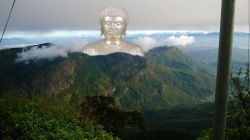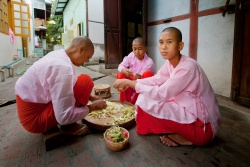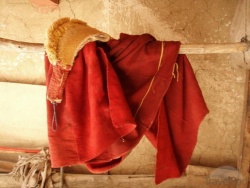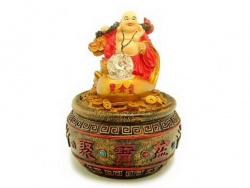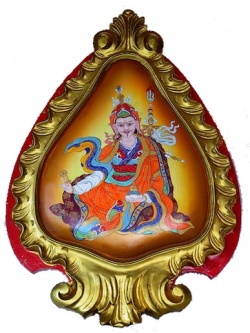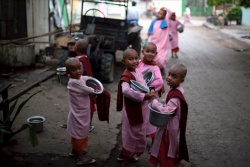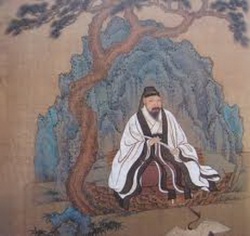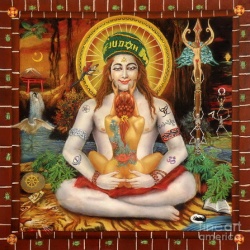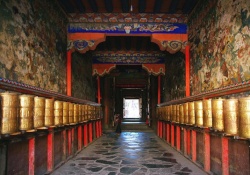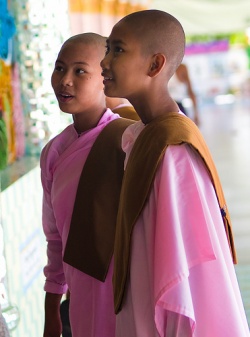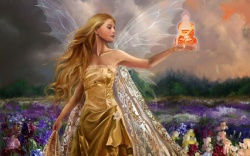Jonang
- See also : History of the Jonang Tradition
- See also : History of the Jonang Tradition
A Brief History
In 1294 Kunpang Thukje Tsondru (1243-1313), a disciple of Choku Odzer and holder of the Dro lineage of the Kalachakra Tantra, settled in mountain caves in South Central Tibet in U-Tsang in a place called “Jomonang,” starting the Jonang tradition. The most famous scholar of this school who developed the shentong view of extrinsic or “other” emptiness, Dolpopa Sherab Gyaltsen (1292-1361), arrived there in 1321. The shentong view was first articulated in Tibet by the Kalachakra yogi Yumo Mikyo Dorje (11th century), a disciple of the Kashmiri scholar Somanatha who along with the Tibetan translator Dro Lotsawa Sherab Drak translated the root tantra of the Kalachakra practice along with the main commentary Stainless Light from Sanskrit into Tibetan and brought the Dro lineage of the Kalachakra Tantra into Tibet.
Kashmiri scholar Somanatha who along with the Tibetan translator Dro Lotsawa Sherab Drak translated the root tantra of the Kalachakra practice along with the main commentary Stainless Light from Sanskrit into Tibetan and brought the Dro lineage of the Kalachakra Tantra into Tibet.
Until quite recently, it was thought that this school no longer existed. The Fifth Dalai Lama, primarily for political reasons but under the excuse of doctrinal differences, tried to wipe out this sect in the seventeenth century. After the supreme head of the sect at that time, Master Jetsun Tarantha (1575-1641) died in Mongolia, the Jonang monasteries were consolidated into the Geluk system and many of the Jonang texts destroyed or confiscated. Master Taranatha reincarnated as Bogdo Zanabazar (1635-1723), the first Jebtsundampa, becoming the spiritual head of the Geluk lineage in Mongolia. However, those Jonang temples outside of the influence of the central government that were hidden in the mountains in remote areas of eastern Tibet remained and flourished. Some of the most powerful dharma kings in the world today belong to this sect. H. H. Dharma King Jigme Dorje Rinpoche is the current supreme head of the Jonang Sect. The 14th Dalai Lama has appointed the present Jebtsundampa Khutukhtu as the representative of the Jonang tradition in India and affirmed that the earlier suppression of the Jonang was based on political, not doctrinal considerations.
Although the Jonang Dharma King, Ngagwang Pedma Namgyal Palzangpo, has taught the Kalachakra practice in the USA, the Jonang teachings are still not widely known in the West. The Jonang Sect has preserved and holds the highest and most complete form of Kalachakra practice.
In Shambhala & India
According to tradition, the root text of the Kalachakra Tantra was first revealed by the Buddha Shakyamuni as the magical manifestation of the Kalachakra deity to King Suchandra of Shambhala who traveled to India in order to request and receive this tantra. At the glorious Drepung stupa in South India, a year after his complete enlightenment, it is said that the Buddha displayed the Wondrous Lunar Mansion Mandala, performed the Kalachakra empowerment and taught the tantra to King Suchandra and countless other human and non-human beings.
Upon returning to the realm of Shambhala, King Suchandra began teaching and transmitting the Kalachakra Root Tantra. This tantra has then been passed down successively to the present 21st Kalkin of Shambhala. King Yashas, an emanation of Manjushri then composed the Condensed Kalachakra Tantra while his son, Kalkin Pundarika composed the primary commentary on the Condensed Kalachakra Tantra titled, Vimalaprabha or Stainless Light.
Then, as the legend is told, one day in the 10th century while walking along a path in northern India, the master Jamyang Dorje had a vision of his meditation deity Manjushri who instructed him to follow the path northwards. Along his way, Jamyang Dorje encountered an emanation of the 11th Kalkin of Shambhala who performed the entire Kalachakra empowerment and transferred this tantric lineage of realization onto him. After meditating for 6 months on the profound yogic practices that he received from the Kalkin, Jamyang Dorje was able to transport himself to Shambhala. While there in Shambhala, he studied the Kalachakra Tantra further with the Kalkin before returning to India. Upon his return, Jamyang Dorje became known as "Kalachakrapada the Elder."
The Kalachakra Tantra and its commentary were then passed on from Kalachakrapada the Elder to his younger successor Shribhadra or "Kalachakrapada the Younger." The lineage of these tantric teachings continued onto Nalendrapa (otherwise known as Bodhibhadra) and then to the Kashmiri master Somanatha. This succession of esoteric transmission passed from Somanatha to his disciple, the Tibetan translator Dro Lotsawa Sherab Drak. Dro Lotsawa together with Somanatha translated the root tantra along with the Stainless Light commentary from Sanskrit into Tibetan, initiating the Dro lineage of the Kalachakra Tantra in Tibet.
The Early Jonangpa
One of the Kashmiri scholar Somanatha's disciples, the 11th century Kalachakra yogi Yumo Mikyo Dorje (b. 1027) is regarded as one of the earliest Tibetan articulators of a zhentong ("shentong," gzhan stong) view -- an understanding of the absolute radiant nature of reality. Emphasized within the Kalachakra Tantra and the Buddha's 3rd turning teachings on Buddhanature, this view would later become emblematic of the Jonangpa. From Yumo Mikyo Dorje onwards, the Dro lineage of the Kalachakra passed on through the lineage-holders Dharmeshvara, Namkha Odzer, Machig Tulku Jobum, Drubtob Sechen, Choje Jamyang Sarma and Choku Odzer.
In the year 1294, Choku Odzer's disciple, Kunpang Thukje Tsondru (1243-1313) settled in the meditation caves (sgrub phug) on the mountains in the place called "Jomonang" in U-Tsang, South Central Tibet. From that time onwards, the spiritual tradition associated with that place has been referred to as "Jonang,", and those who adhere to the practices that were preserved and transmitted at Jomonang have been known as the "Jonangpa."
The Jonang lineage continued on through the great masters Changsem Gyalwa Yeshe (1257-1320) and Yontan Gyatso (1260-1327). Then in 1321, a 29 year old charismatic scholar from the Dolpo region of present-day Nepal arrived in Jomonang. A year later, after having traveled throughout Central Tibet, he returned to the Great Mountain Retreat at Jomonang where he requested the complete empowerment and transmission of the Dro lineage of the Kalachakra Tantra and its completion stage 6-fold vajrayoga from Yontan Gyatso, the throne-holder at Jonang. After spending several years in meditation retreat, this young master from Dolpo -- Dolpopa Sherab Gyaltsen, was requested to succeed Yontan Gyatso and assume leadership as heir to the Jonang.
From 1330 to 1333, while constructing Tibet's largest embodiment of enlightenment, the Great Stupa of Jonang, Dolpopa began formulating and codifying his meditative realizations. In 1334, Dolpopa instructed his disciples, the translator Lotsawa Lodro Pal (1299-1353) and Lotsawa Sazang Mati Panchen (1294-1376) to prepare a new Tibetan translation of the Kalachakra Tantra and its commentary, Stainless Light. These Jonang translations were undertaken to most profoundly explicate the hidden definitive meaning within the tantra and its commentary, serving as the textual basis for Dolpopa's innovative and syncretic teachings.
Systematizing his teachings within the cosmological schema derived from the Stainless Light commentary on the tantra, Dolpopa formulated his realizations of extrinsic emptiness or zhentong -- the contemplative understanding that one's enlightened essence is empty of everything other than the absolute nature of clear light reality. Contextualizing his elucidations within the history of Buddhism and the Four Cosmic Eons, Dolpopa emphasized how the Kalachakra and Buddhanature teachings mark the Krtyuga or Perfect Age.
Crystallizing in his masterpieces, Mountain Dharma: An Ocean of Definitive Meaning and The Fourth Council, Dolpopa clarified how his realizations are in alignment with the Buddha's enlightened intent. These teachings are understood to be definitive in meaning (nges don) in contrast to teachings of the degenerative age that remain interpretive in meaning (drang don).
While Dolpopa was alive, his formulations remained secretive instructions (lkog chos) that were circulated within intimate circles of his closest disciples. During the 80 years that followed Dolpopa's death, his instructions became widely dispersed and popularized as "zhentong," allowing these teachings of the Jonangpa to flourish throughout the Land of Snows.
Dolpopa's successors Lotsawa Lodro Pal, Chogle Namgyal, Sazang Mati Panchen, and Nyawon Kunga Pal upheld the Jonang tradition after Dolpopa's passing. Then in the 16th century, the enigmatic figure Kunga Dolchok (1507-1566) sparked a renaissance within the Jonang. This is best represented in his collection of Tibet's essential spiritual advice titled, The One Hundred and Eight Essential Guidance Instructions of the Jonang.
This Jonang renaissance spirit carried on through Kunga Dolchok's reincarnation Jetsun Taranatha (1575-1635). As the 16th lineage-holder in the Jonang line of succession from the time of Kunpang Tukje Tsondru, Taranatha constructed Takten Damcho Ling Monastery, and played an enormous role in the religious life of 17th century Tibet. Known for his historical works on Buddhism, Jetsun Taranatha was a foremost expert on the tantras of the Sarma or new translation period. He compiled and arranged the Kalachakra Tantra as well as other main tantras into easily accessible practice manuals and composed some of the most lucid expositions on the 6-fold Vajrayoga ("six yogas") or completion stage practices of the Kalachakra.
The Living Tradition
After the passing away of Jetsun Taranatha in the mid-17th century, the Jonangpa became a target for political and territorial power-struggles in U-Tsang, Central Tibet. With surmounting factional rivalries and divided allegiances amongst Jonang and Geluk patrons and the Mongol Army's solidifying of Geluk power, Jonang political and territorial influence began to wane. As Mongol military might enthroned and endorsed the 5th Dalai Lama (1617-1682), and the Geluk political administration ruled, the Jonang were forced out of Central Tibet.
In the year 1650, the 5th Dalai Lama sealed and banned the study of zhentong, prohibiting the printing of Jonang zhentong texts throughout Tibet. Then in 1658, the 5th Dalai Lama forcibly converted Jonang Takten Damcho Ling (Phuntsok Choling) Monastery into a Geluk Monastery — officially initiating the demise of the Jonangpa in U-Tsang.
Although the sphere of Geluk political and military influence reached to the borders of Central Tibet, it did not penetrate the far northeastern domain of Amdo, Tibet. Here, in the remote valleys and vast countrysides of the Dzamthang, Golok and Ngawa regions, the Jonangpa took refuge and made their home.
Beginning in the year 1425 with the establishment of Choje Monastery by Chogle Namgyal's disciple Ratnashri (1350-1435), the Jonangpa have lived in the Dzamthang and surrounding counties of Amdo. Under the imperial patronage of the Ming Court of China, the Jonangpa were able to thrive. In fact, by the mid-16th century, the Jonangpa had consolidated their monastic complexes within the Dzamthang area in Amdo to the extent that they were the local imperial regents. This is where the Jonangpa later gathered during their 17th century Geluk persecution. Surviving outside the range of Geluk influence, the Jonangpa have been building monasteries and transmitting their vital teachings on zhentong and the Kalachakra Tantra ever since.
With the late 19th century luminaries such as Jamgon Kongtrul (1813-1899) and Jamyang Khyentse Wangpo (1820-1892), the Rime or eclectic movement was born in Kham, Eastern Tibet. Sparked by the writings and compilations of these figures, including Kongtrul's Five Treasures, there was the occasion for a re-kindling of interest in the Jonang tradition and zhentong literature. Inspiring many of the great masters from Kham at this time such as Dza Patrul Rinpoche and Jamgon Mipham, the Jonang Kalachakra completion phase practices and distinctive zhentong view gained attention from other traditions as well. Meanwhile this period continued to produce some of the greatest masters of contemporary Jonang thought up through the late 20th century, including Bamda Geleg (1844-1904) and Khenpo Ngawang Lodro Drakpa (1920-1975).
In the 1960's, many of the great living exemplars of the Jonang were forced out of their monasteries, and they fled into the countryside of Amdo where they wandered as nomads or took shelter in caves as yogis. Over the next two decades, the Jonangpa lived without homes in their homeland, gathering during the summer for their annual rains-retreat in order to continue to transmit their lineage. After the Cultural Revolution in 1976, the Jonangpa began returning to their monasteries where they have been rebuilding monasteries and reviving their unique spiritual tradition up to today.
The Jonang (Tibetan: ཇོ་ནང་, Wylie: Jo-nang, ZYPY: Qonang; Chinese: 觉囊) is one of the schools of Tibetan Buddhism. Its origins in Tibet can be traced to early 12th century master Yumo Mikyo Dorje, but became much wider known with the help of Dolpopa Sherab Gyeltsen, a monk originally trained in the Sakya school. The Jonang school was widely thought to have become extinct in the late 17th century at the hands of the Fifth Dalai Lama who forcibly annexed the Jonang monasteries to his Gelug school, declaring them heretical. Recently, however, it was discovered that some remote Jonang monasteries escaped this fate and have continued practicing uninterrupted to this day. According to Gruschke, an estimated 5,000 monks and nuns of the Jonang tradition practice today in areas at the edge of historic Gelug influence.
History
In 1294, the monk Kunpang Tukje Tsondru established the Puntsok Choling monastery at Jomonang, about 160 km northwest of the Tashilhunpo Monastery in Ü-Tsang (Shigatse), and the spiritual tradition that was established here became known as Jonang.
The Jonang tradition combines two specific teachings, what has come to be known as the zhentong (or shentong) philosophy of emptiness, and the Dro-lineage of the Kalachakra tantra. The origin of this combination in Tibet is traced to the master Yumo Mikyo Dorje - an 11th/12th century pupil of the Kashmiri master Somanatha.
After several centuries of independence, however, in the late 17th century the Jonang order came under attack by the Fifth Dalai Lama who converted their monasteries to the Gelug order.
The Jonang school has generated a number of renowned Buddhist scholars, like Dolpopa Sherab Gyeltsen (1292–1361), but the most famous was Jetsun Taranatha (1575–1634). Taranatha placed great emphasis on the Kalachakra system of tantra. After the Jonang monasteries were forcibly converted to the Gelug lineage, their Kalachakra teachings were absorbed into the Gelug school. Taranatha's influence on Gelugpa thinking continues even to this day in the teaching of the present 14th Dalai Lama, who actively promotes initiation into Kalachakra.
Doctrinal/Philosophical reasons for suppression of the Jonangpa
While the Gelugpa embraced the Jonang teaching on the Kalachakra, they ultimately opposed the Jonangpa (followers of the Jonang) over a difference in philosophical view. Yumo Mikyo Dorje, Dolpopa Sherab Gyeltsen and subsequent lamas maintained a teaching known as zhentong, which holds that only the clear-light, non-dual nature of the mind is "real", and everything else is empty of inherent existence. The Gelug school held the distinct but related rangtong view that all phenomena are empty (of inherent existence) and no thing or process (including Mind and its qualities) may be asserted as independent or inherently real (neither may phenomena be asserted as "unreal" - in short, both extreme assertions are seen to be groundless, and the middle way that phenomena are non-inherently real is asserted). For more information on the subject of emptiness in Buddhism, see Śūnyatā.
For the Jonangpas, the emptiness of ultimate reality should not be characterized in the same way as the emptiness of apparent phenomena because it is prabhāsvara-saṃtāna, or "clear light mental continuum," endowed with limitless Buddha qualities. It is empty of all that is false, not empty of the limitless Buddha qualities that are its innate nature.
Political reasons for suppression of the Jonangpa
Modern historians have identified two other reasons which more likely led the Gelugpa to suppress the Jonangpa. First, the Jonangpa had political ties that were very vexing to the Gelugpa. The Jonangpa, along with the Kagyupa, were historical allies with the powerful house of Tsang, which was vying with the Dalai Lama and the Gelug school for control of central Tibet. This was bad enough, but soon after the death of Taranatha an even more ominous event occurred. Taranatha's reincarnation was discovered to be a young boy named Zanabazar the son of Prince Tüsheet Khan, ruler of Central Khalkha. Tüsheet Khan and his son were of Borjigin lineage (imperial clan of Genghis Khan and his successors), meaning they had the birth authority to become Khan. When the young boy was declared the spiritual leader of all of Mongolia, suddenly the Gelugpa were faced with the possibility of war with the former military superpower of Asia. While the Mongol Empire was long past its zenith, this was nonetheless a frightening prospect and the Dalai Lama sought the first possible moment of Mongol distraction to take control of the Jonangpa monasteries.
The 14th Dalai Lama confirmed this view in Glenn Mullin's The Fourteen Dalai Lamas (Clear Light Publishers, p. 207):
- "These monasteries were closed for political reasons, not religious ones, and their closing had nothing to do with sectarianism. They had supported the Tsangpa king in the uprising, thus committing treason. The Great Fifth believed that they should be closed in order to insure the future stability of the (Tibetan) nation, and to dissuade other monasteries from engaging in warfare."
He continued,
- "The fact is that the Great Fifth passed laws outlawing sectarian skirmishes, and passed laws ensuring the freedom of religion. This freedom was extended to not only the Buddhist schools, but also to the non-Buddhist ones. For example, he kept a Bonpo lama in his entourage to speak for the interests of the Bon movement. And on a personal level, he himself practiced so many non-Gelukpa lineages that the Gelukpas criticized him for straying from his roots."
However, in The Buddha from Dolpo: A Study of the Life and Thought of the Tibetan Master Dolpopa Sherab Gyaltsen, scholar Cyrus Stearns details that the writings of Dolpopa Sherab Gyaltsen (1292–1361) and even those of Sakya proponents of zhentong were sealed and banned from publication and study, and that the Jonang monks and nuns forcibly were converted to the Gelug lineage.
Rediscovery
The Jonangpa were until recently thought to be an extinct heretical sect. Thus, Tibetologists were astonished when fieldwork turned up several active Jonangpa monasteries, including the main monastery called Tsangwa located in Tibet, Dzamthang County. Almost 40 monasteries, comprising about 5,000 monks, have subsequently been found, including some in the Amdo and Gyarong districts of Qinghai and the Tibet Autonomous Region.
Interestingly, one of the primary supporters of the Jonang lineage in exile has been the 14th Dalai Lama of the Gelugpa lineage. The Dalai Lama donated buildings in Himachal Pradesh state in Shimla, India for use as a Jonang monastery (now known as the Main Takten Phuntsok Choeling Monastery) and has visited during one of his recent teaching tours. The Karmapa of the Karma Kagyu lineage has also visited there.
The Jonang tradition has recently officially registered with the Tibetan Government in exile to be recognized as the fifth living Buddhist tradition of Tibetan Buddhism. The 14th Dalai Lama assigned Khalkha Jetsun Dampa Rinpoche or the 'Bogd Gegeen' of Mongolia (who is considered to be an incarnation of Taranatha) as the leader of the Jonang tradition.
Much of the literature of the Jonang has also survived, including the Treatise on Other-Emptiness and the Buddha-Matrix by Döl-bo-ba Śay-rap-gyen-tsen, consisting of arguments (all supported by quotations taken from the generally accepted orthodox canonical Vaipūlya Sūtra-s) against "self-emptiness" and in favor of "other-emptiness", which has been published in English translation under the title Mountain Doctrine.
References
- Mullin, G. The Fourteen Dalai Lamas: A Sacred Legacy of Reincarnation. ISBN 1-57416-039-7.
- Gruschke, A. (2000). The Jonangpa Order - Causes for the downfall, conditions of the survival and current situation of a presumably extinct Tibetan-Buddhist School. Ninth Seminar of The International Association for Tibetan Studies
- Gruschke, Andreas (2001): "Monasteries of the forgotten Jonangpa". In: The Cultural Monuments of Tibet’s Outer Provinces: Amdo, vol. 2, White Lotus Press, Bangkok 2001, pp. 71–80. ISBN 974-7534-90-8
- Stearns, Cyrus (1999). The Buddha from Dolpo: A Study of the Life and Thought of the Tibetan Master Dolpopa Sherab Gyaltsen. State University of New York Press. ISBN 0-7914-4191-1 (hc); ISBN 0-7914-4192-X (pbk)
- Jeffrey Hopkins (translator); Kevin Vose (editor) : Mountain Doctrine. Snow Lion, Ithaca, 2006.
External links
- Tibetan Buddhist Rime Institute - Holder of Kalachakra Jonang
- History of the Jonang Tradition - International Kalachakra Network
- [1] Abstract for Gruschke, A. (2000). The Jonangpa Order - Causes for the downfall, conditions of the survival and current situation of a presumably extinct Tibetan-Buddhist School. Ninth Seminar of The International Association for Tibetan Studies
- Theosophy in Tibet: The Teachings of the Jonangpa School by David Reigle
- Main Takten Phuntsok Choeling Monastery, Shimla
- Jonangpa in Russia
